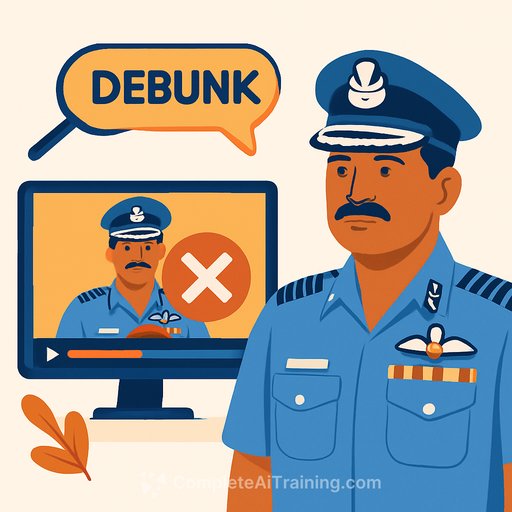Government refutes fake AI-generated video of Air Chief Marshal Amarpreet Singh
The Government has clarified that a circulating video attributed to Air Chief Marshal Amarpreet Singh is fake and digitally altered. The Fact Check Unit of the Press Information Bureau confirmed the manipulation and stated that he has not made any such statement. The advisory adds that AI-manipulated videos are being pushed to create panic and mislead the public.
Why this matters for government teams
Deepfakes erode trust in official communication and can trigger unnecessary escalation. Fast, coordinated verification and a clear counter-message prevent misinformation from taking root. Treat incidents like this as both a public communication issue and a security event.
Rapid response checklist
- Capture first. Preserve URLs, timestamps, and platform IDs. Save the file and note where and when it appeared.
- Verify internally. Alert your nodal officer and communications lead; cross-check with PIB and your ministry's designated fact-check contact.
- Run a quick technical triage. Check for lip-sync mismatch, inconsistent lighting and shadows, unnatural blink rates, and audio artifacts. Extract key frames for closer review.
- Issue a short public rebuttal. State that the video is fake, digitally altered, and that no such statement was made. Add a visible "FAKE" overlay if you republish the clip for context.
- Use takedown and reporting channels. File platform reports from official accounts and escalate through established government contacts.
- Synchronize all touchpoints. Brief social handles, spokespersons, call centers, and regional offices with a one-liner and a link to the official clarification.
- Document the incident. Log indicators of manipulation, platforms involved, and response times for post-action review.
Preventive measures to reduce impact
- Publish official statements in multiple formats (text transcript, signed PDF, and recorded video) to create verifiable reference points.
- Adopt content authenticity practices (e.g., cryptographic signing/metadata for official media) and maintain a consistent visual/audio signature for spokesperson videos.
- Run periodic drills on misinformation response with clear SLAs and role ownership across PR, IT, and legal.
- Train frontline teams to spot manipulation cues and to route suspected content through the fact-check workflow immediately.
What to communicate to the public
- State clearly: the video is fake and digitally altered; no such statement was made.
- Ask citizens to refrain from sharing and to rely on official channels for updates.
- Point to your verified handles and PIB's updates for authoritative information.
Useful references
For official clarifications and myth-busting, follow PIB's updates: Press Information Bureau. For staff upskilling on AI literacy and verification practices, see curated training by role: Complete AI Training - Courses by Job.
Your membership also unlocks:






